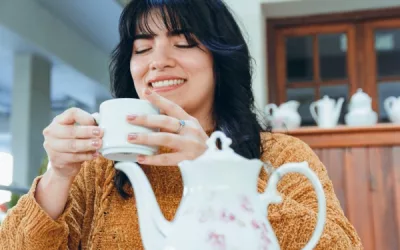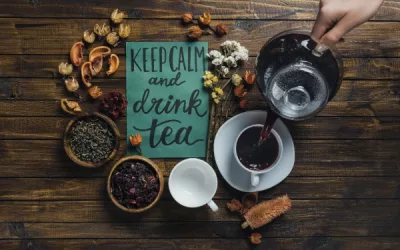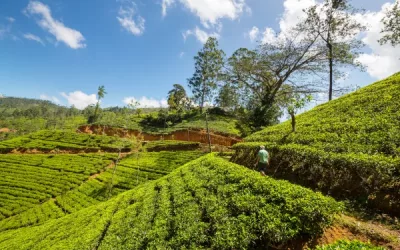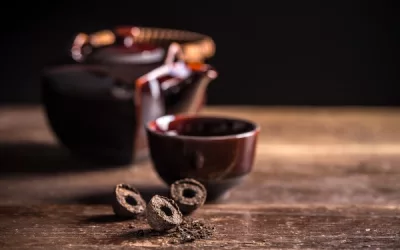Have you ever wondered if you can enjoy the soothing ritual of tea without the caffeine jitters? Decaffeinated tea offers a delightful solution, allowing tea lovers to savour their favourite brews at any time of day. As more people seek caffeine-free options for health or personal reasons, understanding decaffeinated tea becomes increasingly relevant. This article will explore what decaffeinated tea is, how it’s made, its health benefits, flavour nuances, and the best brands available, equipping you with everything you need to make informed choices about your tea experience.
Table of Content
- What is decaffeinated tea?
- How is decaffeinated tea made?
- Is decaffeinated tea completely caffeine-free?
- How does decaffeination affect the flavour of tea?
- What are the best brands of decaffeinated tea?
- Where can you find decaffeinated tea?
- What should you consider when brewing decaffeinated tea?
- Conclusion
What is decaffeinated tea?
Decaffeinated tea, often called “decaf tea,” is tea that has had most of its caffeine removed. Typically, tea leaves contain various levels of caffeine, depending on the type of tea and how it’s processed. Decaf tea offers a chance to enjoy the flavour and health benefits of tea without the stimulating effects of caffeine. This makes it a perfect choice for anyone looking to reduce their caffeine intake for health reasons or preferences.
Decaffeinated tea comes in various types, including black, green, and herbal teas. The decaffeination process usually leaves a small amount of caffeine, but significantly less than in regular tea. Common methods for removing caffeine include using water, carbon dioxide, or solvents. Each method has its pros and cons, affecting both the flavour and health benefits of the tea. Despite the decaffeination process, decaf tea still retains many of the beneficial compounds such as antioxidants and polyphenols.
What defines decaffeinated tea?
Decaffeinated tea has a specific definition which centres on its reduced caffeine content:
- Reduced Caffeine: Decaf tea has had most of its caffeine removed, typically about 97-99%.
- Different Methods: The decaffeination can be achieved using different techniques like carbon dioxide, water extraction, or natural solvents.
- Retention of Flavour and Health Benefits: It retains many of the essential flavours and health-promoting antioxidants found in regular tea.
- Consumer Choice: Provides an option for tea lovers who want to enjoy tea without the jolt of caffeine.
Decaffeinated tea is ideal if you’re sensitive to caffeine or simply prefer to avoid it, especially before bedtime. With the different methods of decaffeination, you can find a tea that suits your taste preference while still enjoying the health perks like lower cholesterol levels and better heart health.
How does decaffeinated tea differ from regular tea?
Decaf tea is distinct from regular tea in several ways:
- Caffeine Content: Regular tea contains more caffeine, which can range from about 15-70 mg per cup, depending on the type.
- Decaffeination Process: Decaf tea undergoes additional processing to remove caffeine, which can also affect the flavour profile slightly.
- Health Implications: Regular tea offers the quick stimulating effect of caffeine, while decaf tea focuses more on health benefits without the jittery feeling.
- Flavour Nuances: Some methods of decaffeination can alter the taste slightly, making it less robust than its caffeinated counterparts.
- Preserved Nutrients: Despite undergoing decaffeination, decaf tea retains most of the vitamins, antioxidants, and other beneficial compounds.
These differences make decaf tea an attractive option if you want to avoid the effects of caffeine while still relishing the rich flavours and health advantages of tea.
What are the common types of decaffeinated tea?
Decaf tea comes in many varieties. Here are some popular choices:
- Decaf Black Tea: Often enjoyed for its strong, hearty flavour, decaf black tea retains the rich, robust taste of traditional black tea.
- Decaf Green Tea: Offers a lighter, more refreshing taste, while still providing numerous health benefits like antioxidant properties.
- Decaf Herbal Tea: Includes blends like chamomile, mint, and ginger that naturally have low to no caffeine even before the decaffeination process.
- Decaf Oolong Tea: Combines the characteristics of both black and green tea, known for its flowery and rich flavour.
- Decaf White Tea: Subtle and delicate flavoured tea that is minimally processed, preserving many of its natural compounds.
Decaf varieties offer something for every palate and provide an excellent way for you to enjoy the myriad flavours of tea without the caffeine kick.
In the early 20th century, Ludwig Roselius, a German coffee merchant, discovered how to remove caffeine from coffee beans after they were submerged in seawater. This breakthrough inadvertently laid the foundation for decaffeinated tea.
Although his method was for coffee, it spurred further exploration into decaffeination processes applicable to tea and other beverages. Eventually, techniques improved to remove caffeine without significantly affecting the flavour or beneficial compounds, paving the way for the delightful decaf teas we have today.
How is decaffeinated tea made?
Decaffeinated tea is made using various methods that remove most of the caffeine content while trying to preserve the tea’s original flavours and health benefits. Knowing how decaffeinated tea is made helps you understand what you’re drinking and appreciate the differences in taste and quality.
Here’s a detailed look at the methods used to create decaffeinated tea.
The table provided below covers various decaffeination methods. It includes process descriptions, advantages, disadvantages, and the impact on flavour. To use this table, simply look at the different methods in the first column, then follow across the rows to compare aspects such as advantages, disadvantages, and flavour impacts.
This breakdown will help you understand which method might best suit your taste and health preferences.
Decaffeination methods table
| Method Name | Process Description | Advantages | Disadvantages | Impact on Flavour |
|---|---|---|---|---|
| Ethyl Acetate | Tea leaves are soaked in ethyl acetate, a naturally occurring solvent. | Less expensive, retains some antioxidants. | Slight chemical taste, possible residue. | Mild alteration, somewhat fruity notes. |
| Methylene Chloride | Tea leaves are soaked in methylene chloride, which binds to caffeine and removes it. | Effective in removing caffeine, preserves most of the flavour. | Chemical residue concerns, potential health risks. | Minimal impact, keeps natural flavour strong. |
| Supercritical CO2 | Carbon dioxide under high pressure is used to extract caffeine. | No chemical residues, very effective. | Expensive equipment, energy-intensive. | Slight change, maintains delicate notes. |
| Water Processing | Soaking tea leaves in hot water to extract caffeine and flavour compounds, then re-absorbing the flavour. | No harmful chemicals, maintains some health benefits. | Can be less effective, potentially bland taste. | Noticeable change, often weaker taste. |
| Steam Processing | Steaming tea leaves to extract caffeine, often followed by re-drying. | Chemical-free, natural method. | Less effective, can lose some flavours and antioxidants. | Alters taste, may lose complexity. |
| Carbon Filter Method | Passing tea leaves through carbon filters to remove caffeine. | Natural method, no chemicals. | Pricy, less effective for complete caffeine removal. | Varies, can maintain subtle flavours. |
This table helps you pinpoint the method that aligns best with your preferences, whether you’re after a chemical-free process or one that retains the most flavour. Each method has its upsides and downsides, and understanding these can elevate your tea-drinking experience.
What are the health benefits of decaffeinated tea?
Decaffeinated tea offers various health benefits while allowing you to enjoy the tea without the jittery effects of caffeine.
- Rich in Antioxidants: Decaffeinated tea still retains many antioxidants, which can help prevent disease and boost overall health.
- Better Sleep Quality: Enjoying a cup of tea without caffeine can help you wind down before bedtime.
- Reduced Anxiety: Lower caffeine intake can lead to reduced anxiety and calmer state of mind.
- Hydration: It provides a great way to stay hydrated throughout the day.
- Digestive Health: Many teas assist in digestion and have soothing effects on the digestive tract.
The benefits make decaffeinated tea a perfect choice for those looking to enjoy their favourite beverage without compromising on health. Many prefer decaf for its calming properties and enjoy its health advantages.
What are some popular options for decaffeinated tea?
There are many popular options for decaffeinated tea, so you’re sure to find something you like.
- Decaffeinated Green Tea: Offers the benefits of green tea without the caffeine load.
- Decaffeinated Black Tea: Keeps the robust flavour of black tea intact.
- Herbal Teas: Naturally caffeine-free but often included in the decaf category.
- White Tea: Light and delicate flavours for a gentle tea experience.
- Fruit-Infused Teas: These delights add fruity flavours to your tea cup.
Here are some examples that you may consider trying:
- Twining’s Decaffeinated Earl Grey: A classic choice with its distinctive bergamot flavour.
- Lipton Decaffeinated Green Tea: A budget-friendly option with health benefits.
- Harney & Sons Decaffeinated Hot Cinnamon Spice: Offers a spicy kick without caffeine.
Exploring these options can help you find a decaffeinated tea that suits your taste while providing the health benefits you’re looking for.
In the early 20th century, Ludwig Roselius, a German coffee merchant, accidentally discovered decaffeination. His father had died from severe caffeine addiction, motivating Roselius to create a safer coffee alternative. Through trials and errors— soaking coffee beans in brine, he uncovered the secret of caffeine extraction. This method spread to tea-making, adapting to various processes to refine the flavour and health benefits while minimising caffeine content.
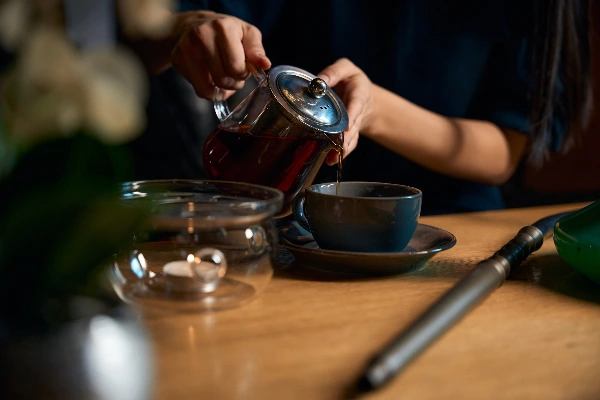
Is decaffeinated tea completely caffeine-free?
The million-pound question: Is decaffeinated tea completely caffeine-free? Sorry to burst your bubble, but the short answer is no. Before you dump your decaf tea down the kitchen sink, let’s chew the cud on this.
Decaffeinated tea still retains a touch of caffeine – think of it like that one mate who just doesn’t get the hint to go home. While the decaffeination process removes most of the caffeine, a smidgen remains. This coffee-substitute darling isn’t exactly tossing you into an uncontrollable spin of jitters, but neither is it the virgin drink you’d think it is.
How much caffeine is typically left in decaffeinated tea?
Here’s the brass tacks: On average, decaffeinated tea contains around 2-5 milligrams of caffeine per cup. This is a far cry from its caffeinated cousin, which can pack 20-90 milligrams per serving. Sure, it’s less, but it’s still there. You won’t be bouncing off the walls, but you might feel a tiny tickle of energy.
- Residual caffeine levels vary based on the type of tea and decaffeination method.
- Black tea tends to retain slightly more caffeine compared to green tea after decaffeination.
- Laboratory tests often confirm these residual levels, ensuring that they meet regulatory standards.
- Despite low caffeine content, very sensitive individuals might still react.
So, while you’re not exactly sipping caffeine-free ambrosia, you’re in pretty low-caffeine territory.
What are the labelling standards for decaffeinated products?
The next thing to acknowledge is labelling – because you’ve got to navigate those supermarket shelves like a caffeine-free ninja. Labelling standards ensure transparency, so consumers aren’t bamboozled by quasi-truths.
- In the UK, for a product to be labelled “decaffeinated”, it must have at least 97% of its caffeine removed.
- The EU has similar standards, demanding less than 0.1% caffeine content by dry weight.
- Manufacturers are mandated to specify “decaf” clearly to inform consumers.
- Differentiating between “decaf” and “caffeine-free” is crucial; the latter means no caffeine was ever present.
- Always check the small print: sometimes percentages speak louder than bold claims.
While labels aren’t poetic literature, they do the job of informing you about what exactly you’re dunking into your mug.
Why is it important to understand caffeine levels in decaffeinated tea?
Grasping the caffeine content in your tea is paramount for several reasons – especially if you’re conscious about your health, chugging down cups like there’s no tomorrow, or you’re simply a curious cat.
- Health implications: Even small amounts of caffeine can affect sleep, blood pressure, and anxiety in sensitive individuals.
- Consumer expectations: Knowing exact caffeine levels helps set realistic expectations for those switching from regular tea.
- Medical reasons: For individuals with certain medical conditions, understanding caffeine levels can be crucial.
- Dietary choices: For those adhering to strict dietary regimens, precision in caffeine intake is essential.
- Kids and pregnancy: Pregnant women and kids have lower caffeine tolerances; hence it’s vital to know what’s in your brew.
In sum, being clued up on caffeine content means you won’t be caught off guard by an unexpected buzz.
How does decaffeination affect the flavour of tea?
Alright, let’s spill the tea on decaf tea! You’ve probably got your hands on a cup of decaffeinated tea, but you can’t help wondering if the flavour has taken a hit. Here’s the scoop: decaffeination affects your tea’s taste, but it’s not the end of the world. We’ll break it down – we’ll talk about flavour compounds, consumer preferences, tasting notes, brewing methods, and throw in some product comparisons for good measure.
Decaffeination is a crafty process, but it can sometimes be a sneaky flavour thief. When you decaffeinate tea, it changes the chemical composition, particularly the flavour compounds. This tweak can make the tea taste a tad different. Imagine removing caffeine and along with that, some flavour nuance is lost. It’s like taking the cream out of your coffee; it’s still coffee but…different!
What changes occur in the flavour profile during decaffeination?
Decaffeination can shuffle the flavour deck of your cuppa.
- Some bitterness and astringency flee the scene with caffeine.
- Herbal or fruity notes might steal the spotlight that was once caffeine’s stage.
- The tea can taste flatter or less robust, like a singer without their back-up vocals.
- Sweet and grassy hints can get somewhat subdued.
- Overall aroma might become mellower, like a whisper compared to a loud conversation.
These changes, though subtle, can be detected if you’ve got a keen nose and a discerning palate.
How do different methods of decaffeination affect taste?
There are a few usual suspects when it comes to decaffeinating tea – each with their own impact on taste.
- Carbon dioxide method: This is like the magician of decaffeination. It preserves more flavour since it’s gentler on the tea leaves.
- Methylene chloride process: It’s efficient but can strip away some of those delicate flavour traits.
- Ethyl acetate method: Using natural solvents, it’s considered ‘natural’, but can lead to more flavour loss compared to CO2.
- Water processing: This method, though the most natural, can sometimes wash away key flavour attributes.
So, depending on how it’s done, decaffeinated tea can taste slightly different. Pick your method wisely, or better yet, have a taste test and find your perfect match.
A historical twist to all this – in the 1970s, Swiss chemist Kurt Zosel, part of the Max Planck Institute, revolutionised the decaffeination process using CO2. His method maintained the tea’s prized flavours while dialing down the caffeine, giving us decaf enthusiasts a better cup. So when you sip on your decaf, give a nod to Kurt; he kept your tea tasty!
What are the best brands of decaffeinated tea?
When it comes to decaffeinated tea, it’s a bit like the countryside: there are plenty of choices, but not all of them are as charming as they seem. Navigating your options in the decaf tea market is easier when you know which brands are holding the crown.
The big names have earned their stripes by consistently delivering on flavour, quality, packaging, and price. Like picking apples from a tree, some brands stand out every season.
What factors should consumers consider when choosing a brand?
Choosing the right decaf tea is like speed dating – assess quickly but look for the essentials.
- Reputation: Go for brands with a history of quality. Nobody wants a tea scandal.
- Flavour: Look for a brand that offers a range of flavours to keep your taste buds entertained.
- Packaging: Convenience and freshness are key. Sealed, easy-to-use packages are your new best friends.
- Price: Balance cost with quality. Some higher-priced teas offer better ingredients and processing methods.
- Consumer Reviews: What’s better than hearing from those who’ve sipped before you?
Having that checklist will help you avoid ending up with a brew that tastes like wet cardboard. Brands that tick all these boxes won’t let you down.
- Related concepts: tea processing methods, antioxidants in tea, consumer preferences
- Historical figures: Thomas Twining (founder of Twinings), Charles Taylor (founder of Taylor’s of Harrogate, which produces Yorkshire Tea)
- Places: Harrogate, England (home to Yorkshire Tea)
- Events: The creation of the first decaffeinated tea by Ludwig Roselius in 1903
How do consumer reviews influence brand selection?
Who knew that scrolling through tea reviews could be so enlightening? It’s like having a bunch of friends to chat to before making your pick.
- Honesty: Reviewers don’t hold back. If a tea tastes like old socks, you’ll know.
- Flavour Profiles: Get insights into the nuances of taste you might not pick up from the box.
- Comparison: Customers frequently compare brands, giving you a clearer picture.
- Consistency: Regular positive reviews indicate a brand that reliably delivers.
- Packaging and Freshness: Comments often highlight how well the tea is packaged and how fresh it tastes upon opening.
Reading reviews before picking a brand is like asking that friend who’s tried every single item on the menu. They save you from potential disappointment and offer nuggets of wisdom that fancy advertising won’t.
Years ago, tea merchants raced to offer the best blends, leading to some interesting historical events. Richard Twining, from the famous Twinings family, once successfully lobbied against a proposed tea tax in 1784.
He managed to save the British tea-drinking public from unnecessary financial strain. So, every time you sip your fine decaffeinated brew, give a little nod to the past – your cuppa legacy is rich indeed.
Where can you find decaffeinated tea?
So, you’ve decided that you need some decaf tea in your life. Great choice! But where do you actually find this caffeine-free bliss? Let’s dive in.
Decaffeinated tea is more common than you’d think. You can find this mellow beverage nearly everywhere – online, in specialty stores, and even at your local supermarket.
How can consumers find local options for decaffeinated tea?
If supporting local businesses makes you feel all warm and fuzzy inside, finding local decaf tea options is a must.
- Farmers’ Markets: Not only can you get fresh veggies, but you might also stumble upon some fantastic locally-produced decaf tea blends.
- Local Tea Shops: There’s something charming about small, local tea shops. They often stock unique blends you won’t find anywhere else, and the staff love to chat about their products.
- Community Boards/Forums: Check out community bulletin boards or local forums. Sometimes, local producers advertise their goods there. Plus, you might get recommendations from fellow tea enthusiasts.
- Word of Mouth: Ask around! Friends, family, and neighbours might know of hidden gems within the community.
- Local Health Stores: These stores often have a selection of locally-produced goods, including our cherished decaf teas.
Exploring these options could lead you to your new favourite tea, all while supporting your local economy.
Let’s cool off with a tale from history. Did you know that early tea trading in the 17th century was a perilous business? The East India Company, for instance, had to navigate treacherous seas and dodge pirates to bring tea to Europe.
Merchants clung to their precious cargo, knowing that tea was highly coveted in European society. So, the next time you sip your decaffeinated tea, remember the lengths people went to so you can enjoy that peaceful moment.
What should you consider when brewing decaffeinated tea?
Brewing decaffeinated tea is a bit like mastering the art of making a perfect omelet. Sure, it seems simple, but a lot can go wrong. You want to avoid making a cup that tastes like stale bathwater or, worse, nothing at all. To get the best out of your decaf, you need to think about water temperature, steeping time, the tea-to-water ratio, types of teapots, and serving suggestions.
Let’s break it down, step-by-step, so you can brew a cuppa that won’t just be a pale comparison of the caffeinated stuff.
What is the ideal water temperature for brewing decaffeinated tea?
Ah, water temperature – the Goldilocks of tea brewing. For decaffeinated tea, it’s crucial to get this just right.
- For black decaffeinated tea: Keep it around 90°C (194°F), just off the boil.
- For green decaffeinated tea: Aim for 80°C (176°F). Boiling water will make it taste like you’ve used lawn clippings.
- For herbal decaf tea: Go full boil at 100°C (212°F). These tougher leaves like it hot.
If you’re thinking of shortcutting the task by microwaving your water – don’t. It’s a sin in Tea Law. Boiling the kettle properly ensures you hit those precise temperatures.
How long should you steep decaffeinated tea?
Steeping time can make or break your tea. Over-steeping leads to bitterness, while under-steeping tastes like you’ve soaked cardboard in water.
- Black decaffeinated tea: 4-5 minutes is your sweet spot.
- Green decaffeinated tea: 2-3 minutes for a flavourful brew that’s not bitter.
- Herbal decaf tea: A good 5-7 minutes to let all the flavours mingle.
A pro tip: Always set a timer. Eyeballing it is for the daredevils who enjoy the taste of steeped socks.
What are the best practices for serving decaffeinated tea?
Now that you’ve got the perfect brew, let’s talk about making it look and taste its best. Presentation and pairing can elevate your tea game from good to sensational.
- Teapots: Use a ceramic or porcelain teapot. They retain heat well and add an elegant touch.
- Strainers: Invest in a good-quality strainer. No one likes tea grit in their cup.
- Cups: Pre-warm your tea cups with a swirl of hot water. Cold cups are the enemy of hot tea.
- Accoutrements: Serve with a splash of milk or a slice of lemon, depending on the tea type. Don’t drown it in honey unless you’re hosting Winnie the Pooh.
- Snacks: Pair your tea with scones, biscuits, or finger sandwiches to make it a posh affair.
By following these practices, your decaf tea will hold its ground against any full-lead cup.
So there you have it – your crash course in decaffeinated tea brewing. If done right, decaf tea can be as delightful and satisfying as its caffeinated counterpart.
Did you know that tea was so integral to British culture that during World War II, ensuring the supply of tea was a top priority? When the German U-boats disrupted the tea supply, the British government set up the Tea Control Board to manage it.
This wasn’t just about getting a nice hot cup of tea; it was about keeping morale high. Tea was rationed just like butter and sugar. Despite the war, the British tenaciously held onto their tea-drinking rituals, proving that in the toughest times, sometimes all you need is a good cup of tea—decaf or not—to keep going.
Conclusion
In exploring the multifaceted world of decaffeinated tea, I’ve uncovered a wealth of information that enriches our understanding of this popular beverage. From its defining characteristics and the various methods of decaffeination to its myriad health benefits, decaffeinated tea offers an appealing alternative for those who wish to enjoy the soothing qualities of tea without the stimulating effects of caffeine.
Moreover, it’s clear that while decaffeinated tea isn’t entirely caffeine-free, the residual levels are significantly lower—an important distinction for health-conscious consumers and those with caffeine sensitivities.
The implications of these observations are profound; they underscore the evolving consumer preferences and the growing recognition of decaffeinated tea as a viable option for diverse lifestyles.
With the range of decaffeinated tea available today—from well-known brands to artisanal selections—there is something to suit every palate. This choice empowers individuals to make informed decisions regarding their health and wellness.
Looking ahead, I encourage tea enthusiasts and newcomers alike to experiment with different brewing techniques and to explore various brands to discover which offers the best flavour and experience for their tastes. As I dive deeper into this delightful realm, I am reminded of the words of Thomas de Quincey: “Tea is the magic elixir of life.” Let’s continue to savour the magic that decaffeinated tea can bring, one cup at a time. What will your next discovery be in this enchanting world?
Resources
- Impacts of Caffeine during Pregnancy
- Maternal caffeine consumption and pregnancy outcomes: a narrative review
- The Impact of Decaffeinated Green Tea Extract on Fat Oxidation, Body Composition and Cardio-Metabolic Health in Overweight, Recreationally Active Individuals
- The Impact of Decaffeinated Green Tea Extract on Fat Oxidation
- Efficient extraction strategies of tea (Camellia sinensis) biomolecules
- Decaffeination—Process and Quality



